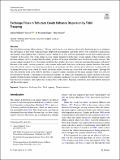| dc.contributor.author | Garcia, Adrian M. P. | |
| dc.contributor.author | Geyer, W. R. | |
| dc.contributor.author | Randall, Noa | |
| dc.date.accessioned | 2021-11-01T14:34:10Z | |
| dc.date.available | 2021-11-01T14:34:10Z | |
| dc.date.issued | 2021-07-13 | |
| dc.identifier.uri | https://hdl.handle.net/1721.1/136914 | |
| dc.description.abstract | Abstract
The North River estuary (Massachusetts, USA) is a tidal marsh creek network where tidal dispersion processes dominate the salt balance. A field study using moorings, shipboard measurements, and drone surveys was conducted to characterize and quantify tidal trapping due to tributary creeks. During flood tide, saltwater propagates up the main channel and gets “trapped” in the creeks. The creeks inherit an axial salinity gradient from the time-varying salinity at their boundary with the main channel, but it is stronger than the salinity gradient of the main channel because of relatively weaker currents. The stronger salinity gradient drives a baroclinic circulation that stratifies the creeks, while the main channel remains well-mixed. Because of the creeks’ shorter geometries, tidal currents in the creeks lead those in the main channel; therefore, the creeks never fill with the saltiest water which passes the main channel junction. This velocity phase difference is enhanced by the exchange flow in the creeks, which fast-tracks the fresher surface layer in the creeks back to the main channel. Through ebb tide, the relatively fresh creek outflows introduce a negative salinity anomaly into the main channel, where it is advected downstream by the tide. Using high-resolution measurements, we empirically determine the salinity anomaly in the main channel resulting from its exchange with the creeks to calculate a dispersion rate due to trapping. Our dispersion rate is larger than theoretical estimates that neglect the exchange flow in the creeks. Trapping contributes more than half the landward salt flux in this region. | en_US |
| dc.publisher | Springer US | en_US |
| dc.relation.isversionof | https://doi.org/10.1007/s12237-021-00969-4 | en_US |
| dc.rights | Creative Commons Attribution | en_US |
| dc.rights.uri | https://creativecommons.org/licenses/by/4.0/ | en_US |
| dc.source | Springer US | en_US |
| dc.title | Exchange Flows in Tributary Creeks Enhance Dispersion by Tidal Trapping | en_US |
| dc.type | Article | en_US |
| dc.contributor.department | Woods Hole Oceanographic Institution | |
| dc.identifier.mitlicense | PUBLISHER_CC | |
| dc.eprint.version | Final published version | en_US |
| dc.type.uri | http://purl.org/eprint/type/JournalArticle | en_US |
| eprint.status | http://purl.org/eprint/status/PeerReviewed | en_US |
| dc.date.updated | 2021-07-18T03:09:08Z | |
| dc.language.rfc3066 | en | |
| dc.rights.holder | The Author(s) | |
| dspace.embargo.terms | N | |
| dspace.date.submission | 2021-07-18T03:09:08Z | |
| mit.license | PUBLISHER_CC | |
| mit.metadata.status | Authority Work and Publication Information Needed | |
